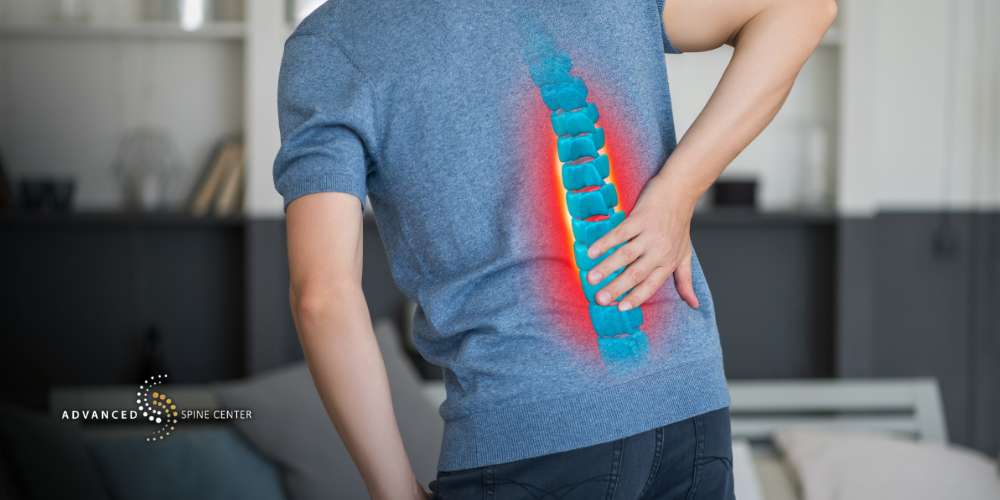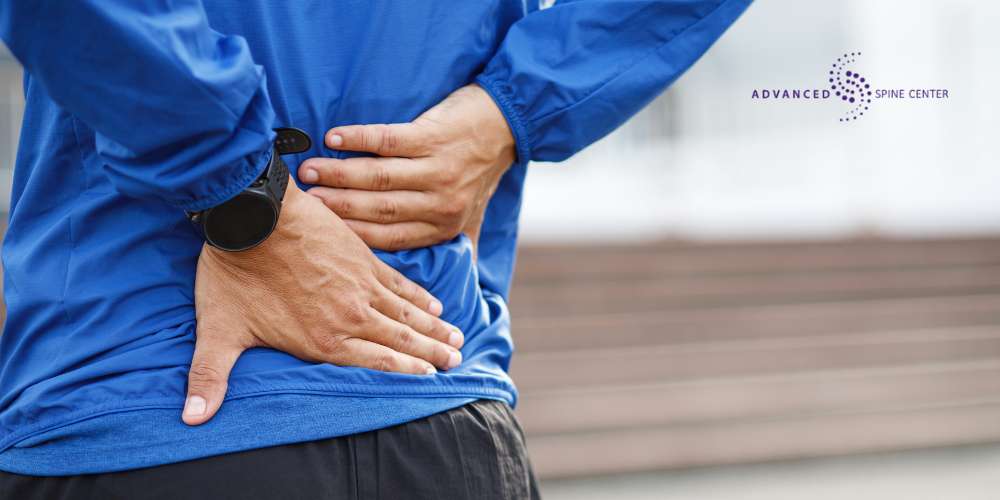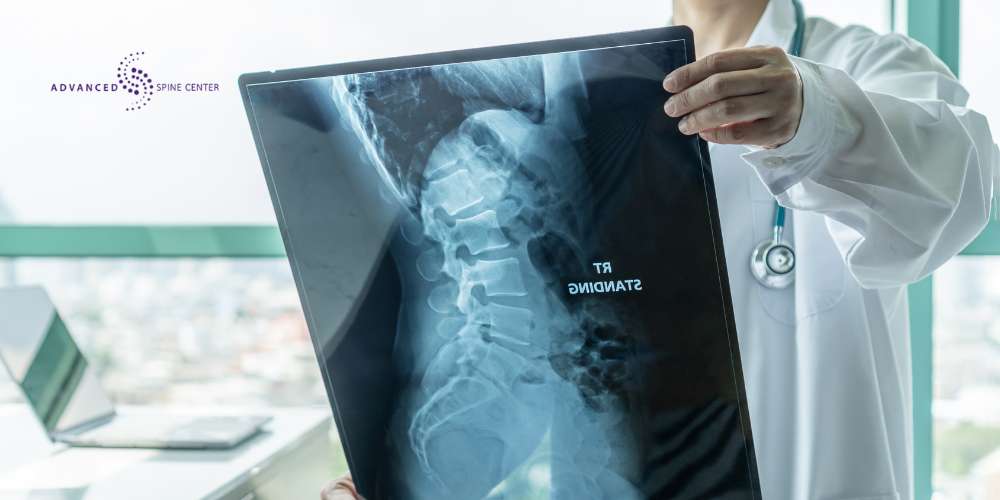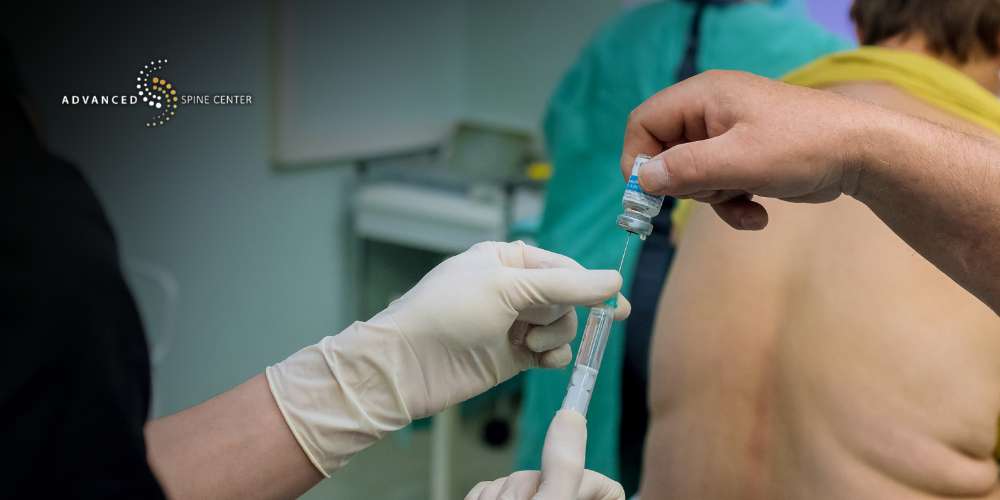Specialties

Living with neurogenic claudication can significantly affect your quality of life, as it often causes discomfort and limits mobility. This condition, typically caused by spinal stenosis, occurs when the spinal canal narrows, placing pressure on the spinal cord and spinal nerves.
At the Advanced Spine Center in Plano, TX, our team is dedicated to helping patients find relief through a variety of effective treatment options, including physical therapy and other advanced solutions.
If you’re struggling with symptoms of neurogenic claudication, call us today at (972)-499-5457 to discuss your options and take the first step toward recovery.
What Is Neurogenic Claudication?
Neurogenic claudication is a condition that stems from issues within the spinal column, most commonly caused by spinal stenosis. This narrowing of the spinal canal can result from degenerative disease, bone spurs, or other age-related changes. As the spinal canal narrows, it compresses the nerve roots, leading to symptoms like leg pain, muscle weakness, and difficulty walking or standing for long periods. A physical exam is often the first step in diagnosing neurogenic claudication, helping doctors identify the cause of your symptoms and determine the most effective treatment plan. If you’re experiencing these signs, seeking expert care can help restore your mobility and alleviate your pain.
What Is Pseudoclaudication?
Pseudoclaudication, also known as neurogenic intermittent claudication, is often confused with vascular claudication because of its similar symptoms, but the underlying cause is distinct. This condition occurs due to issues with the spinal structures, such as the narrowing of the spinal canal in lumbar spinal stenosis, which affects the nerves in the lower extremities.
Many patients with pseudoclaudication experience pain, numbness, or weakness in their legs that worsens with walking or standing and improves when sitting or leaning forward. The degeneration of intervertebral discs is a common contributing factor. While some cases respond well to non-surgical treatments, more severe cases may require surgical interventions to relieve pressure on the nerves and improve mobility.
Neurogenic vs Vascular Claudication
Neurogenic intermittent claudication and vascular claudication are two distinct clinical syndromes that can cause leg pain but arise from different underlying issues. Neurogenic claudication is linked to lumbar spinal stenosis, where the narrowing of the spinal canal compresses the nerve roots, leading to discomfort that improves with rest or changes in posture.
In contrast, vascular claudication is caused by reduced blood flow to the legs, often due to peripheral artery disease. Understanding whether the pain is due to spinal stenosis or blood flow issues is crucial for determining the appropriate treatment.
Neurogenic Claudication vs Radiculopathy
Neurogenic claudication and lumbar radiculopathy are clinical syndromes stemming from nerve compression in the lower spine, but their causes and symptoms differ. Neurogenic claudication typically results from spinal stenosis, where the narrowing of the spinal canal compresses the spinal cord and spinal nerves, leading to pain, weakness, or numbness during activity.
In contrast, lumbar radiculopathy occurs because of lumbar spinal stenosis, or specifically when spinal nerves are compressed, often due to herniated discs or other issues affecting neural structures. While both conditions affect the lower spine, their distinct patterns of nerve involvement require tailored treatment approaches.
What Conditions Are Often Associated with Neurogenic Claudication?

Neurogenic claudication is frequently tied to conditions compromising the spine’s stability and structural integrity. Spinal instability and the narrowing of the spinal canal, often due to lumbar spinal stenosis, are two primary factors that contribute to the compression of spinal nerves. This nerve compression can result in chronic pain, weakness, numbness, and difficulty with mobility, making even simple daily activities challenging for those affected. Over time, these structural issues can worsen, leading to increased discomfort and further complications if left untreated.
These conditions typically develop gradually and are commonly associated with degenerative changes in the spine, such as the natural wear and tear that occurs with aging. Trauma, such as injuries from falls or accidents, and other spinal disorders like herniated discs or spondylolisthesis, can also play a role in exacerbating instability and narrowing within the spinal canal. Early diagnosis is critical to identify the underlying cause of neurogenic claudication and to develop an effective treatment plan tailored to the patient’s needs.
With proper care, which may include physical therapy, pain management, or surgical interventions, individuals can achieve significant relief from symptoms.
Spinal Stenosis with Neurogenic Claudication
Spinal stenosis with neurogenic claudication occurs when central stenosis, or narrowing of the central spinal canal, compresses the nerve roots. With central canal stenosis, compression disrupts normal nerve function, causing leg pain, numbness, weakness, and difficulty with mobility, particularly in older adults. The condition often results from age-related degeneration in the spine and can significantly impact daily activities and quality of life.
Because its symptoms can mimic other conditions like vascular claudication or radiculopathy, a thorough differential diagnosis is essential. This process involves a medical history review, physical examination, and imaging studies like MRIs or CT scans to identify the exact cause of the nerve compression.
Once diagnosed, treatment options may include physical therapy, pain management, or advanced interventions like minimally invasive spinal decompression surgery. These approaches focus on ways to provide pain relief, restoring mobility, and helping patients achieve better function and comfort.
Lumbar Spinal Stenosis with Neurogenic Claudication
Lumbar spinal stenosis with neurogenic claudication is a clinical syndrome where narrowing in the lumbar spine compresses nerves, often leading to back and leg pain. This narrowing can result from degenerative changes, such as a herniated disc, which places additional pressure on the spinal nerves. Patients typically experience intermittent leg pain, which worsens with standing or walking and improves with rest. Proper diagnosis and treatment are essential to manage the symptoms and address the underlying lumbar spine stenosis effectively.
What Causes Neurogenic Claudication?

Neurogenic claudication is most commonly caused by spinal stenosis, a condition where the spinal canal narrows and compresses the spinal nerve roots or spinal cord. This nerve root compression disrupts normal nerve function, leading to pain, numbness, and weakness, particularly in the legs. Unlike vascular claudication, which is caused by reduced blood flow, neurogenic claudication stems from mechanical pressure on the nerves.
Elderly patients are particularly at risk, as age-related changes in the spine often contribute to the narrowing. A physical exam and imaging tests, helps identify the underlying cause and distinguish neurogenic claudication from vascular conditions.
Neurogenic Claudication Test
Diagnosing neurogenic claudication begins with a thorough physical examination, where a doctor evaluates symptoms and checks for normal peripheral pulses to rule out vascular conditions like vascular claudication.
Imaging tests such as computed tomography (CT) scans and magnetic resonance imaging (MRI) are crucial for confirming the diagnosis, as they provide detailed views of the spine to identify narrowing of the spinal canal or nerve compression. Once the condition is diagnosed, treatment options can be explored, ranging from physical therapy to more advanced interventions and surgical techniques tailored to the severity of the case.
Neurogenic Claudication Symptoms
Neurogenic claudication, commonly linked to lumbar spinal stenosis, is a condition that arises when the spinal canal narrows, placing pressure on the spinal cord and nerve roots. This compression interferes with the normal function of the nervous system, resulting in a range of symptoms that can severely impact daily life.
Patients often experience persistent pain, numbness, or weakness in the lower back and legs, which may intensify during activities such as walking, standing, or even light exercise. These symptoms are typically alleviated when bending forward, as this posture helps relieve pressure on the affected soft tissues and nerves, providing temporary relief.
The common signs of neurogenic claudication often go unnoticed in its early stages or may be mistaken for other conditions like vascular claudication. However, as patients start to develop symptoms like, the narrowing of the spinal canal, the symptoms become more pronounced and debilitating, making simple tasks like grocery shopping or climbing stairs increasingly difficult.
Recognizing these symptoms early is essential, as timely diagnosis and treatment can prevent further deterioration and improve overall quality of life. If left untreated, the condition may lead to more severe complications, emphasizing the importance of seeking medical attention when symptoms first appear. With proper care, individuals suffering from neurogenic claudication can regain mobility and enjoy a better quality of life.
Does Neurogenic Claudication Go Away?
Neurogenic claudication caused by spinal stenosis typically does not resolve on its own, but symptoms can often be managed effectively. Many patients find relief through nonsurgical treatments, such as physical therapy, which focuses on strengthening the back and improving mobility. Bending forward is a common position that temporarily eases discomfort by reducing pressure on the spinal nerves.
While these methods can provide significant pain relief, the symptoms of neurogenic claudication may persist or worsen over time if the underlying cause progresses. Seeking early intervention and exploring tailored treatment options is essential for managing symptoms and maintaining a good quality of life.
Neurogenic Claudication Treatment Options in Plano, TX

For individuals with neurogenic claudication caused by lumbar spinal stenosis, several treatment options are available in Plano, TX. Nonsurgical treatments, such as physical therapy, pain medicine, and epidural steroid injections, are often the first steps to manage symptoms and reduce inflammation. For patients who do not find relief through a conservative treatment, surgical treatment may be necessary.
Surgical procedures like spinal surgery or lumbar fusion surgery aim to address the underlying issue, providing more permanent pain relief. While these surgical treatments can be highly effective, they also come with risk factors that should be carefully evaluated with your doctor to determine the best approach for your condition.
Lumbar Spine Decompression Surgery
Lumbar spine decompression surgery is a highly effective solution for individuals suffering from spinal stenosis and intermittent neurogenic claudication. These conditions often lead to debilitating back pain, leg discomfort, and reduced mobility, significantly impacting daily life.
This type of spine surgery aims to relieve pressure on the nerves in the lower back by addressing the structural issues causing the compression. By alleviating this pressure, patients can experience a significant reduction in pain and improved overall function.
One of the most advanced approaches to this procedure is minimally invasive lumbar decompression (MILD). This surgical technique uses smaller incisions, which not only reduce the risk of complications but also shorten recovery times and minimize post-operative discomfort. These surgical interventions create more space within the spinal canal, addressing the root cause of the symptoms.
Lumbar spine decompression surgery is especially beneficial for patients who have not responded to nonsurgical treatments like physical therapy or medication. With the potential to restore mobility and enhance quality of life, this procedure offers a renewed sense of hope for those affected by severe spinal conditions.
Microdiscectomy
A type of spine surgery often performed to relieve pain caused by a herniated disc pressing on spinal nerves is called a lumbar microdiscectomy. This procedure is a form of spinal decompression that involves removing the portion of the disc causing nerve compression, alleviating symptoms like leg pain and weakness. As a minimally invasive surgery, microdiscectomy typically results in quicker recovery times and less post-operative discomfort compared to traditional procedures, making it a highly effective option for many patients experiencing debilitating nerve pain.
Laminectomy
Laminectomy is a surgical procedure used to treat lumbar spinal stenosis by relieving pressure on the affected nerves. During the procedure, a portion of the vertebra called the lamina is removed to create more space within the spinal canal, reducing inflammation and nerve compression. This procedure is often recommended for patients experiencing severe pain or mobility issues that have not improved with nonsurgical treatments. A laminectomy can significantly improve symptoms and enhance quality of life.
Neurogenic Claudication Treatment Exercises
Exercises tailored for neurogenic claudication are a key component of physical therapy and can significantly relieve back pain. These exercises focus on strengthening the muscles that support the spine, improving flexibility, and promoting better posture. As part of a conservative treatment plan, they are considered an effective nonsurgical treatment option for managing symptoms.
Physical therapy exercises are designed to reduce pressure on the nerves, improve mobility, and help patients return to daily activities with less discomfort. Working with a qualified physical therapist ensures these exercises are safe and effective for your condition.
Contact the Advanced Spine Center for Neurogenic Claudication Treatment in Plano, TX

If you’re struggling with the symptoms of neurogenic claudication, the Advanced Spine Center in Plano, TX, is here to help. Our experienced team provides comprehensive care, from conservative treatments like physical therapy to advanced surgical options, all tailored to your unique needs.
Don’t let back pain or mobility issues hold you back any longer. Call us today at (972) 499 -5457 to schedule a consultation and take the first step toward lasting relief and an improved quality of life.


